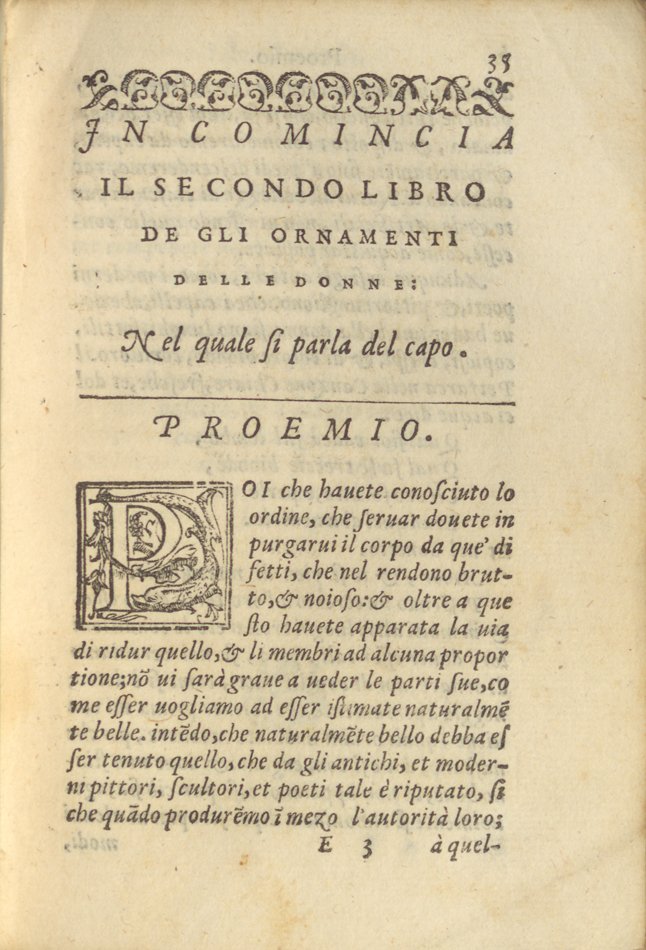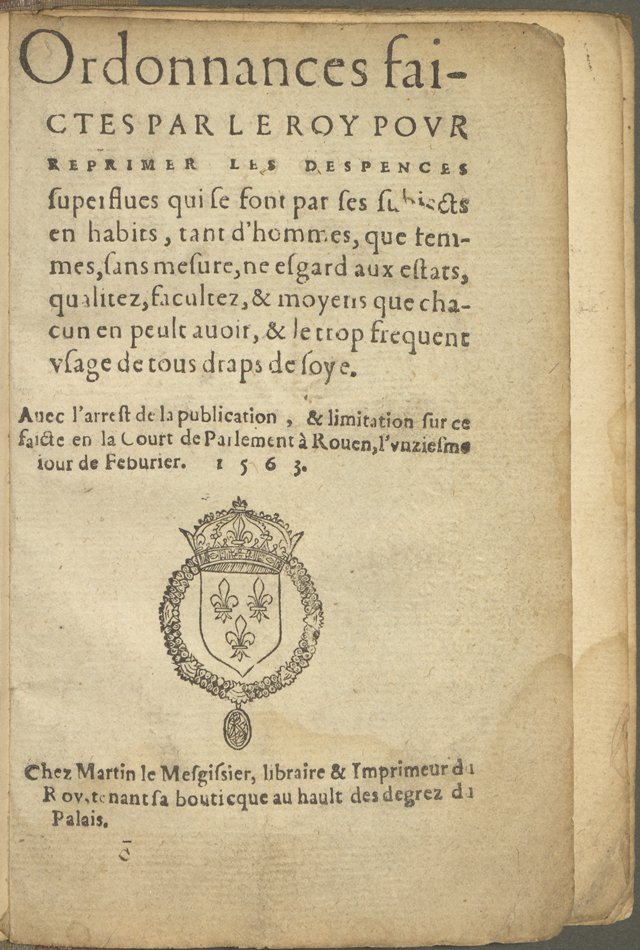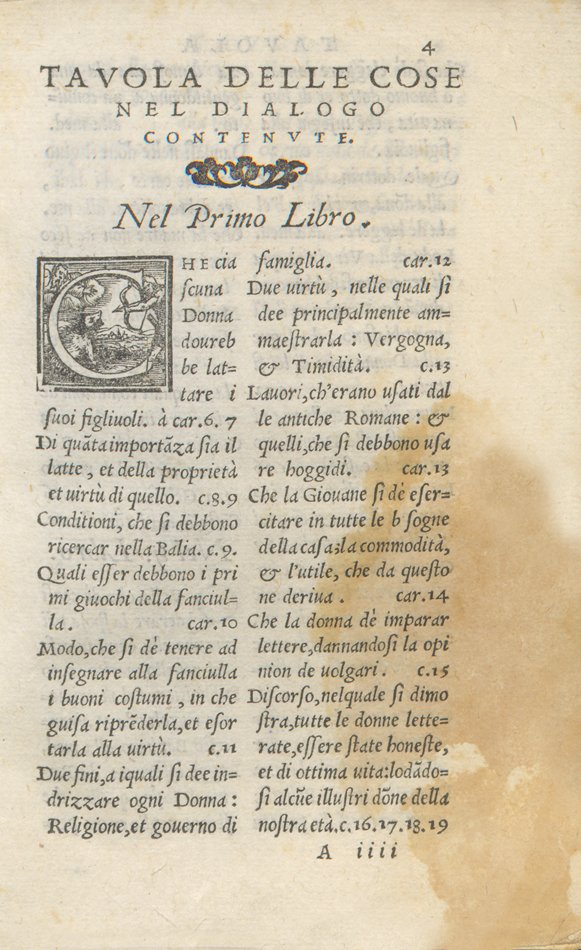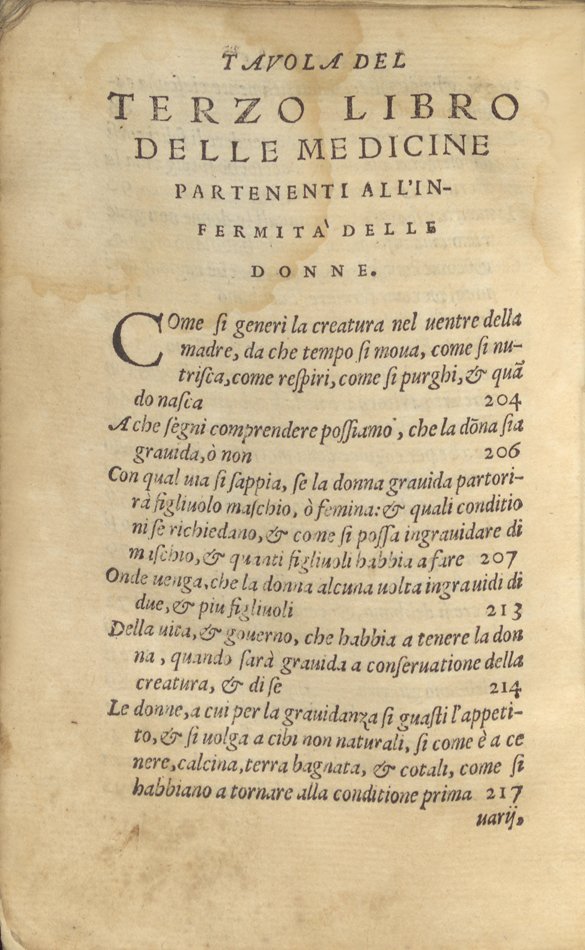Male Voices Defining Urban Women
Focusing on Venice and Paris—two of the most internationally visible Renaissance cities—these objects reveal how male voices in urban spaces strove to exert control over women. Treatises on women’s health, conception and childbirth were one avenue. Written by male scholars, such works stressed the natural weakness of women, who—they argued—needed someone stronger to take charge of their bodies, and their reproductive health. Attempts to control dress and ideals of beauty were another avenue. Sumptuary laws, restricting the expense and style of clothing, focused on female attire, as in a 1433 Florentine law aiming:
“To restrain the barbarous and irrepressible bestiality of women who, not mindful of the weakness of their nature, forgetting that they are subject to their husbands, and transforming their perverse sense into a reprobate and diabolical nature, force their husbands with their honeyed poison to submit to them.”
Through moralizing admonitions that women should value spiritual purity above vain ornaments, such laws propagated a specific definition of an admirable woman: virtuous, silent, and subservient to her parents and husband. Manuals of advice for women, generated by male courtly voices, rooted feminine virtues in aesthetic qualities of the body. A woman’s praiseworthy interior qualities should manifest, not through action, but through appearance, beauty and attire drawing viewers to admire the virtues a woman contained, as a gilded reliquary advertised its blessed contents. The woman, objectified as an ornament or container for virtue, would influence the world primarily by drawing the male eye to gaze upon something good.

Antoine Estienne
A Paris: Chez Sebastien Niuelle, 1585
Rare Books Collection
Published in 1570, Franciscan Friar Antoine Estienne calls for French women to give up their ostentatious, dishonest, and wicked vanity. He warns Christians against inciting God’s fury through their search for novelty in clothing and ornaments, and assigns women a traditional, biblical role in urging them to lead a movement of national repentance and moral reform. For example, he advises them to streak their faces with ashes instead of using cosmetics, and to wear sackcloth and hair shirts instead of linen and silk.

Giovanni Marinello (16th century)
In Venetia: Appresso Giovanni Valgrisio, 1574
Rare Books Collection
The Italian physician Giovanni Marinello’s book is a comprehensive manual on female beauty and adornment containing, among hundreds of recommendations, advice on cosmetics and more than two dozen recipes for making dyes to bleach hair blond. Each of the four chapters is dedicated to a part of the female body, which is materially and visibly dismembered on the page, thus reflecting a fetishist desire aimed at the construction of an ideal body for men’s visual pleasure.

Antoine Estienne
A Paris: Chez Sebastien Niuelle, 1585
Rare Books Collection
Published in 1570, Franciscan Friar Antoine Estienne calls for French women to give up their ostentatious, dishonest, and wicked vanity. He warns Christians against inciting God’s fury through their search for novelty in clothing and ornaments, and assigns women a traditional, biblical role in urging them to lead a movement of national repentance and moral reform. For example, he advises them to streak their faces with ashes instead of using cosmetics, and to wear sackcloth and hair shirts instead of linen and silk.

Giovanni Marinello (16th century)
In Venetia: Appresso Giovanni Valgrisio, 1574
Rare Books Collection
The Italian physician Giovanni Marinello’s book is a comprehensive manual on female beauty and adornment containing, among hundreds of recommendations, advice on cosmetics and more than two dozen recipes for making dyes to bleach hair blond. Each of the four chapters is dedicated to a part of the female body, which is materially and visibly dismembered on the page, thus reflecting a fetishist desire aimed at the construction of an ideal body for men’s visual pleasure.

[Paris]: Chez Martin le Mesgissier, 1563
Rare Books Collection, Gift of the Library Society
Sovereign’s reproduction of one of Charles IX four sumptuary legislations deals with limiting conspicuous consumption and extravagant display. Women of all social states and marital status were the main targets of these laws. The limitations refer, for example, to the textiles they were allowed to wear and to the ways they could tie their hair, therefore leaving absolutely no space for personal inclinations and individual expression.

Lodovico Dolce (1508-1568)
In Vinegia: Appresso Gabriel Giolito de Ferrari, 1545
Rare Books Collection
One of the most successful works on female conduct written in sixteenth-century Italy, Dolce’s Dialogo is a discourse between a man, Flaminio, and the widow, Dorotea. The widow is taught rules of conduct that are “shaping and assembling to perfection unmarried girls, married women, and widows.” Moral virtues such as chastity and honesty are strictly defined. The table of contents illustrates the detailed division of instructions that go from food and clothing, allowed and prohibited games, to discourse and conversation advice according to different social situations.
In 1563, following both medical tradition and popular lore, Giovanni Marinello devoted over 300 pages to problems related to reproduction and the functioning of the uterus. He also included practical advice aimed at coping with the burden of infertility, which was usually blamed on woman. This treatise was freely adapted into French by Jean Liébault in 1582 to recast it for a French readership. Imbued with moral judgments, he described the sterile woman as empty (vide), a failure at fulfilling her procreative role, and proposed strategies to counter this “disease.”


